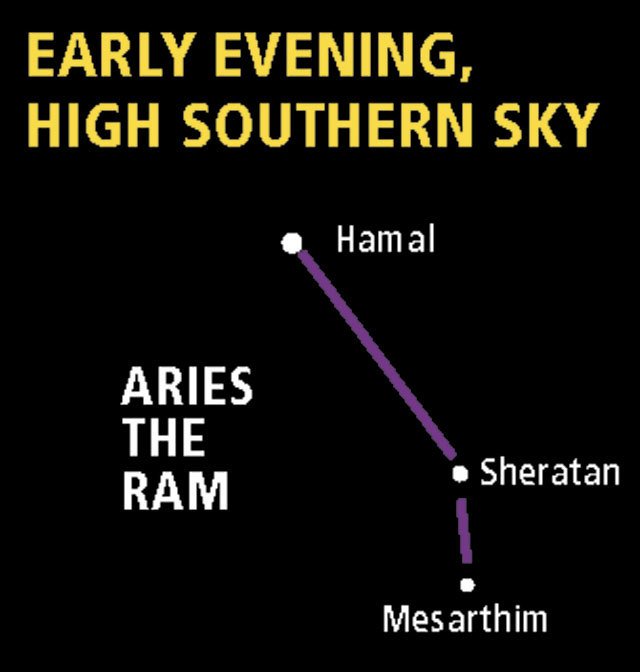Aries the Ram is certainly not the smallest constellation in the night sky, although it sure appears to be.
Constellations are more than dot-to-dot pictures of animals, people or things. They actually make a patchwork quilt across the night sky with parallel and perpendicular boundaries.
The entire sky is divided up into 88 constellations. They aren’t all the same size, though. Aries ranks near the middle. Even though Aries isn’t the largest and flashiest constellation it’s always been one of my favorites, and it possibly has some biblical implications to boot.
Currently, Aries the Ram resides in the early evening, high southern sky, almost overhead. There’s not that much to it, just two medium bright stars and a dimmer one that arguably outlines the horn of a ram. You can’t miss it because it’s very distinct.
Aries is one of the smaller constellations of the zodiac, made up of 13 constellations that stretch in a band all across the night sky. The Zodiac band runs about 8 degrees on either side of the sun’s apparent path among the stars as Earth orbits the sun. Since all of the major planets in our solar system circle the sun in nearly the same mathematical plane, give or take a few degrees, the planets are always found somewhere in the zodiac band at any one time or another.
Where any given planet is along the zodiac band depends on where it is in its orbit around the sun and where the Earth is in our solar circuit. For example, the very bright planet Venus in the low southwest sky is shining in the constellation Aquarius the water bearer, while Mars, just to the upper left of Venus, resides in Pisces the fish.
The constellation Aries and the bright planet Jupiter are major players in one of the theories about the “Star of Bethlehem.” Jupiter might have been the Christmas star shining in the constellation Aries the Ram around the time Christ was born. There’s even a Roman coin that depicts this event.
The two brighter stars of Aries are Hamel on the upper left, and Sheratan on the lower right. The dimmer star just below Sheratan is Mesarthim. Hamel is a giant star in our Milky Way galaxy, more than 850 trillion miles or 66 light-years away from Earth. It’s so far away that the light you see from Hamel today left that star back in 1951, when a gallon of gas cost 20 cents. Hamel is about 15 times the diameter of our own sun and almost 100 times as luminous.
Clarification on eclipse viewing
In last week’s column, I featured the solar eclipse that’ll take place Aug. 21. In Snohomish County, it’ll be a very deep partial eclipse. It’ll will be a total eclipse though along a narrow strip from coast to coast across the 48 states.
I told you that during a partial eclipse you’ll need special eclipse glasses to safely watch the moon creep across the sun’s face. You never want to stare at the partially eclipsed sun without them. You can really damage your eyes — or worse.
My mistake was that I also told you that if you’re in the path of the total eclipse, that you could take your glasses off a few seconds before totality sets in. To be perfectly safe, you should keep wearing your glasses until totality begins. While the risk of hurting is eyes is lower for just a quick glance or two at that point, you’re much better off keeping the glasses on. Safety first!
Talk to us
> Give us your news tips.
> Send us a letter to the editor.
> More Herald contact information.

























